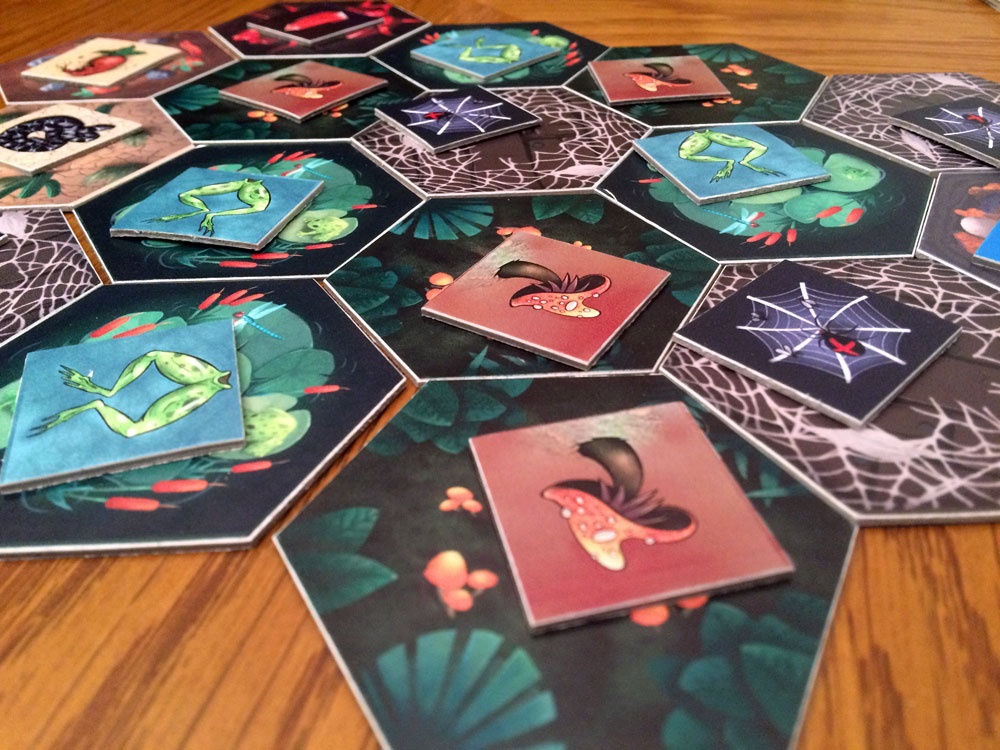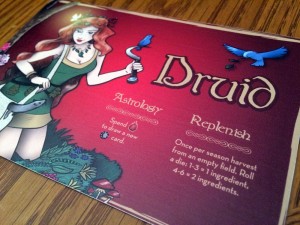Note: This preview uses pre-release components and rules. What you see here may be different from the final, published game.
 While in school, I found that I loved one particular part of chemistry class. I wasn’t enamored with learning about atomic weights, acid & bases, or the periodic table. I enjoyed we were able to go back into the lab and conduct some chemical reactions. Having the opportunity to mix different components together to create something completely different was both entertaining and unfortunately forced me to learn something. I think that was why I was interested in giving Cauldron sometime on my gaming table. In Cauldron, players are collecting sets of eldritch ingredients to brew potions and cast spells to be the first to earn 35 Magik to become Grand Infusionist. The game has a lot more going for it than just resource management so let’s to it.
While in school, I found that I loved one particular part of chemistry class. I wasn’t enamored with learning about atomic weights, acid & bases, or the periodic table. I enjoyed we were able to go back into the lab and conduct some chemical reactions. Having the opportunity to mix different components together to create something completely different was both entertaining and unfortunately forced me to learn something. I think that was why I was interested in giving Cauldron sometime on my gaming table. In Cauldron, players are collecting sets of eldritch ingredients to brew potions and cast spells to be the first to earn 35 Magik to become Grand Infusionist. The game has a lot more going for it than just resource management so let’s to it.
Game Overview:
Players take control of one of seven magic wielders, each with their own unique skills on a quest to master the art of potion making. The game is separated into two phases, one being the harvest season, which will consist of harvesting resources from different fields and brewing potions to earn Magik (victory points). The second is the market season, where players will buy new potion recipes, spells, and plant new fields for more ingredients to harvest. To pay for these new things, players will need to spend the Magik they have earned during the game. This creates a balancing act for players to manage as they go throughout to the game. Unfortunately, the resources needed to brew potions are not unlimited and those pesky other potion makers are looking to make a name for themselves. Players will have to time their moves carefully to be the first to earn enough Magik points to win the game.
How to Play:

The game starts with players selecting characters, setting up the Magik track and placing the starting fields. These hexagonal fields are where the ingredients will grow. Players will also be able to add new fields as the game progresses. Each round starts with the Harvest season with the same for steps taking place.
1. Draw an Omen Card: Omen cards introduce a one-time or ongoing effect that takes place during this Harvest season.
2. Populate the Board: Each field out on the board will receive one corresponding ingredient token. This process can be altered by the omen card drawn for this phase.
3. Determine Turn Order: Players will roll six-sided die, with the highest going first.
4. Take Actions or Quick Actions: This is where the meat of the action in this season takes place. Players will continue this step until all the Ingredient tokens are harvested. Players will have to take ONE of the following Actions and as many Quick Actions as they can.
Actions:
- Harvest: Take one available token from the field
- Steal: Attempt to steal an Ingredient token from another player. Players will roll their six sided die and if they roll above a four they are successful.
- Brew: Combine the necessary ingredients to brew a Potion and then players will move their character token up the Magik track.
Quick Actions:
- Brew a Quick Potion: These are special potions that allow you to brew quickly rather than taking a whole action.
- Cast a Spell: Players can cast as many spells as they like then discard the card after the actions on the card are carried out.
- Move Ingredients: If you have purchased a cellar card during the Market season, you can place a token on this card. This protects it from being stolen in most cases and from spoiling at the end of the Harvest season.
After the last ingredient is taken off the field and that player completes any quick actions then the season is over. All ingredients that are not placed on a cellar card spoil immediately and must be placed back in the general supply.
The Market Season is very simple. In turn order, players make one purchase during this phase of new fields, basic or advanced spells and potions, or cellars. Players will spend the Magik they have earned during the game. After each player has made a purchase or passed on their turn, the next Harvest season begins. The game will continue until one player has earned 35 Magik points at the end of a Harvest season and they win the game.
The only other thing to note about the game is that there are certain events that trigger only after a player has reached a certain number of Magik points for the first time. These can hinder players above a certain point threshold, open up advanced cards to be purchased or give extra points when brewing potions.

Game Experience:
There are many resource management games out in the marketplace and for a game to stand out it needs to do something different. Cauldron did that on its theme alone for me. I loved the idea of collecting resources to create new and more powerful potions. Not only do I find that the theme works but the mechanics in the game are well-done.
I like how the game is separated into two distinct seasons. This isn’t necessarily anything new, but after playing the game it’s nice to have the action taking and buying phases divided. This allows players to focus on what they have in front of them during the Harvest season. Having players draw new potions or planting new fields would slow the game down. I do like the pace of the game. Each season moves quickly with little down time.

One of the unexpected aspects of Cauldron was the level of player interaction. While the market season doesn’t have much in the way of butting heads, the harvest season is ripe with it. Because most of the potions require one of the ingredients not available at the start of the game, players will be fighting over those limited resources throughout the entire game. The spells in the game also add to the interaction. Most of the ones I encountered hindered your opponents in some way. This can lead to a gang up on the leader element toward the end of the game. Anyone in the lead will have to watch their back as the rest of the players are likely coming after them.
I think the defining thing about Cauldron that makes it different from other resource management games is the fact that the currency in the game is your victory (Magik) points. You might think you will be able to save all your Magik throughout the game and win, but you can’t do that. In my experience, players will spend Magik early in the game as soon as they get it to improve the potions they have, increase production of a rare ingredient, or buy a cellar. The game takes five or so turns before the players start making some elaborate potions. But as players get into the later game, they must spend those Magik carefully as to not fall behind other players, because they might not have enough time to catch up. It is an interesting internal battle as you decide what to do.

The last thing I want to mention is the different characters you can play in the game. There’s a nice variety of archetypes like druid, shaman, wizard and the like, but what makes them special is that they each have their own special abilities. Some of these can be used once a season or as many times as you can meet the requirements of those powers. Each one of the character’s powers slightly changes how a player must act during the game to improve their chances of winning. I want to note that despite having seven different sets of character powers, they all seem very balanced. While the game play changes every time as you get different spells and potions, playing different characters really changes the game on a more drastic scale.
Final Thoughts:
Cauldron manages to put a nice spin on a traditional set collection and resource management game. Since the game currency is the overall victory points, this really forces players to balance their short and long term goals. The game is very balanced with players constantly jockeying for position as they move up the Magik board. With each character in Cauldron having unique powers, players are required to change how they play each game. Also, the high amount of interaction in the game makes it feel like you are fighting against the other players rather than just building your own potion expertise. Cauldron’s creative theme makes it intriguing to new players and is easy to teach and play. If it sounds like a game you want to have in your collection, consider giving them your support on their Kickstarter page.
If you’d like to become a backer, pledges start at $29 the full game and stretch goals. Cauldron is scheduled to be in backers hands in January of 2016 and you have until Thursday, May 28th to become a backer. Head over today and check it out.
As always, we don’t post ratings for preview copies as the components and rules may change from the final game. Check back with us after the game is produced for a full review.





















Very detailed review! Thanks for the break down.